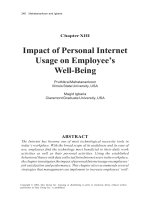Diversity in the Workplace & Environmental Protection
Bạn đang xem bản rút gọn của tài liệu. Xem và tải ngay bản đầy đủ của tài liệu tại đây (1.09 MB, 33 trang )
SOME OF THE MAJOR FEDERAL
EMPLOYMENT DISCRIMINATION LAWS
1964 Civil Rights Act - Title VII
Enacted to improve the economic and social conditions of women
and minorities.
Title VII is the broadest of the laws dealing with discrimination in
many aspects of the employment relationship and prohibits
discrimination against employees or job applicants on the basis of:
Race
Color
Religion
National Origin
Sex
Title VII prohibits any practices or procedures, which limits or
adversely affects employment opportunities on the basis of the
protected classes, including:
advertising
testing
assignments
training
disciplinary actions
layoffs
recruitment
referrals
hiring
transfers
promotions
benefits
terminations
recalls
compensation
apprenticeships
and all other terms, conditions and privileges of employment . Title VII
covers employers with 15 or more employees.
Retaliation
Title VII also prohibits any reprisals or adverse action against
an individual or group of individuals because they have
opposed discriminatory practices, participated or assisted, in
any way, in a charge investigation or proceeding brought under
its provisions.
EXECUTIVE ORDERS
Orders issued by the President to regulate employers who do
business with federal government agencies.
A number of executive orders have been issued that prohibit
employers, holding federal government contracts, from discriminating
against employees and applicants on the basis of:
Race
Religion
Sex
Color
National origin
Age
Executive Order 11246
Under E.O. 11246, government contractors and subcontractors, who
do over $10,000 in government business in one year, are required to
refrain from discriminating in employment decisions such as:
Recruitment, Advertising, Layoffs, Terminations,
Compensation, Training, Demotions, etc..
And to engage in affirmative steps to ensure that applicants and
employees receive equal employment opportunity regardless of
race, color, religion, national origin, sex, or age.
In addition, each government contractor with 50 or more employees
and $50,000 or more in government contracts is required to develop
a written affirmative action plan for each of its establishments
AFFIRMATIVE ACTION
♦ Good faith efforts by employers to address past
and/or present discrimination through a variety of
specific, results-oriented procedures
♦ Actions appropriate to overcome the effects of
past or present practices, policies, or other
barriers to equal employment opportunity.
♦ Not preferential treatment.
♦ Should not unnecessarily trammel the rights of
the non-minorities
Affirmative action helps an employer identify problem areas, set
goals and take positive steps to guarantee equal employment
opportunities for people in a protected class.
The focus is placed on hiring, promoting, and
training protected-class members where they
are underrepresented in an organization in
relation to their availability in the labor markets
from which recruiting occurs.
In addition to being required by E.O. 11246,
affirmative action can also be initiated :
• voluntarily
• as a result of conciliation or litigation; or
• under other federal, state, or local laws.
Utilizes GOALS not QUOTAS
Civil Rights Act of 1991 (amends Title VII)
Places a heavier burden on the employer to defend itself against
charges of intentional discrimination.
Provides that an employment practice that adversely impacts a
protected class is unlawful if the employer cannot demonstrate that the
challenged practice is:
(1) job related for the position in question, and
(2) consistent with a business necessity.
Allows compensatory and punitive damage awards in cases of
intentional discrimination
Also allows jury trials to determine the liability for and the amount of
compensatory and punitive damages, subject to established caps.
The Equal Pay Act of 1963
The Equal Pay Act (EPA) was passed as a major amendment to
the Fair Labor Standards Act , prohibiting discrimination on the
basis of sex in the payment of compensation, including benefits.
An employer cannot discriminate between employees
on the basis of sex by paying different wage scales
for equal work, on jobs requiring:
equal skill,
effort,
responsibility, and
performed under similar working conditions
•
•
The EPA applies to both men and women.
Job titles cannot be used to disguise discrimination in pay.
For example, if a male “janitor” and a female “cleaning woman” are
performing substantially “equal” work, their pay must be comparable.
The Age Discrimination in Employment Act
1967
The Age Discrimination in Employment Act (ADEA)
prohibits employment discrimination on the basis of age
against anyone age 40 and over.
The ADEA makes it illegal for employers to
discriminate in:
terms,
conditions, or
privileges of employment and compensation
because of an individual’s age.
The Pregnancy Discrimination Act of
1978
The basic principle of the Pregnancy
Discrimination Act (PDA) is that
women affected by pregnancy and
related conditions must be treated the
same as other applicants and
employees on the basis of their ability
or inability to work.
Employers have to treat maternity
leave and leave for other pregnancyrelated conditions the same as other
personal or medical leaves.
A woman may not be refused a job
or promotion merely because of
pregnancy or related conditions.
Vietnam Era Veterans Readjustment
Assistance Act
1972 & 1974
Protects:
• Vietnam-era veterans;
• qualified special disabled veterans; and
• veterans who served on active duty for 180
days or more during a war or in a campaign or
expedition for which a campaign badge has
been authorized.
It prohibits employment discrimination and requires
employers with federal contracts or subcontracts of
$25,000 or more to provide equal opportunity and
affirmative action.
Uniformed Services Employment &
Reemployment Rights Act of 1994
The USERRA prohibits employment discrimination
because of an employee’s or applicant’s past,
current, or future military obligations.
The law seeks to ensure that those
who serve their country can retain
their civilian employment and
benefits, and can seek employment
free from discrimination because of
their service.
It requires employers to reinstate employees, upon
honorable completion of their military duty, to their former
jobs.
Enforced by the VETS & OSC
Immigration Reform and Control Act of 1986
The Immigration Reform and Control Act
was passed to control unauthorized
immigration to the United States and to
deal with problems arising from the
continued flow of immigrants.
The IRCA prohibits discrimination against
any individual with respect to hiring,
recruitment, or the discharging of the
individual from employment because of
national origin or citizenship status.
Individuals in this country illegally are not protected.
The Act also forbids employers to knowingly hire or recruit illegal
immigrants (immigrants who do not possess lawful work
authorization) .
Enforced by the OSC
Rehabilitation Act of 1973
The Rehabilitation Act prohibits employment
discrimination against qualified individuals with
disabilities.
The Act applies to federal government contractors and
sub-contractors whose contracts are in excess of
$10,000, and programs that receive federal funds.
An employee defined to be covered under the Act
is the same as one covered under the Americans
with Disabilities Act.
The person must be qualified for the job in order to
be protected from job discrimination.
An individual must meet the following criteria to be considered a
person with a disability:
Has a physical or mental impairment that substantially limits
one or more major life activities;
Has a record of such impairment ; or
Is regarded as having such an impairment.
An individual only has to meet one of the three criteria.
Genetic Information Nondiscrimination Act of
2008
The GINA prohibits genetic information discrimination in employment.
Under Title II of GINA, it is illegal to
discriminate against employees
because of genetic information. Title
II prohibits the use of genetic
information in making employment
decisions, restricts acquisition of
genetic information by employers
and other entities covered by Title II
and strictly limits the disclosure of
genetic information.
The Americans with Disabilities Act of 1990
As amended by the ADA Amendments Act of 2008
Extends the Coverage of the Rehabilitation Act
Expanded the legal responsibilities, of an employer,
as defined by the Rehabilitation Act and made it
easier for people with disabilities to:
• gain and hold employment,
• have easier access to public places,
• travel on public transportation,
• use public telecommunication services, and
• seek redress when the law is violated.
p. 43
An individual is covered under the ADA if he/she:
has a physical or mental impairment that substantially limits
one or more major life activities;
has a record of such an impairment; or
Is regarded as having such an impairment.
An individual only has to meet one of the three criteria.
The ADA Amendments Act of 2008 (ADAAA) effective Jan 1 2009
Retains the ADA’s basic definition of a “disability” but:
• revises the term “substantially limits”
• expands the definition of “major life activities”
• states that mitigating measures other than “ordinary eyeglasses” shall not be
considered in assessing whether a person has a disability
• clarifies that an impairment that is episodic or in remission is a disability if it
would substantially limit a major activity when active
• states that an employee or applicant is “regarded as” if subject to an action
prohibited by the ADA based on an impairment that is not transitory and minor
• clarifies that individuals “regarded as” are not entitled to a reasonable
accommodation
Implications: employers are likely going to face more instances in which they
need to provide accommodations to employees who might not have been
considered disabled in the past, but who are considered disabled under the
p. 43
new law
The ADA protects those individuals who are disabled and qualified
to perform the essential functions of the job with or without
reasonable accommodation.
The individual must satisfy the position requirements:
•Skills, experience, education, licenses
•Physical and mental requirements
•Meet performance standards
An organization does not have to give
preference, hire, or retain a disabled
individual, if the individual is not qualified to
perform the job.
It does not interfere with an employer’s right to hire the best qualified applicant.
Reasonable Accommodation
A reasonable accommodation is any
change or adjustment to a job or work
environment that permits a qualified
applicant or employee with a disability to
participate in the job application process,
to perform the essential functions of a
job, or to enjoy benefits and privileges of
employment equal to those enjoyed by
employees without disabilities.
When Making a Reasonable Accommodation Consider:
•
the essential functions of the job;
qualifications of the person to perform the essential functions ;
• determination whether a reasonable accommodation can be made for
the qualified individual.
•
An accommodation is not required if it imposes undue hardship.
Undue hardship means that an accommodation
would be unduly
extensive
costly
substantial
disruptive
or would fundamentally alter the nature or operation of the
business









